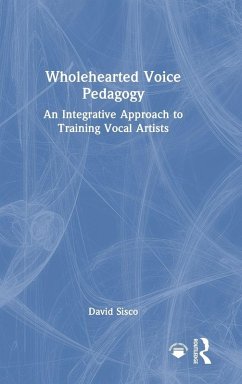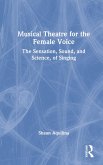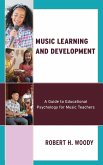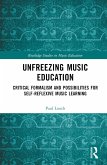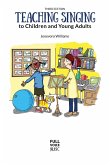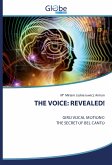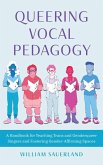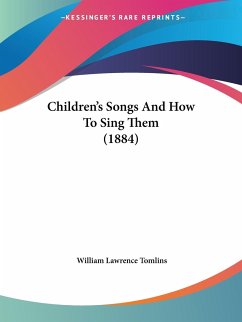- Gebundenes Buch
- Merkliste
- Auf die Merkliste
- Bewerten Bewerten
- Teilen
- Produkt teilen
- Produkterinnerung
- Produkterinnerung
Wholehearted Voice Pedagogy: An Integrative Approach to Training Vocal Artists investigates how to develop healthy, equitable, student-teacher relationships in both applied and independent voice lessons.
Andere Kunden interessierten sich auch für
![Musical Theatre for the Female Voice Musical Theatre for the Female Voice]() Shaun AquilinaMusical Theatre for the Female Voice152,99 €
Shaun AquilinaMusical Theatre for the Female Voice152,99 €![Music Learning and Development Music Learning and Development]() Robert H. WoodyMusic Learning and Development110,99 €
Robert H. WoodyMusic Learning and Development110,99 €![Unfreezing Music Education Unfreezing Music Education]() Paul LouthUnfreezing Music Education149,99 €
Paul LouthUnfreezing Music Education149,99 €![Teaching Singing to Children and Young Adults Teaching Singing to Children and Young Adults]() Jenevora WilliamsTeaching Singing to Children and Young Adults55,99 €
Jenevora WilliamsTeaching Singing to Children and Young Adults55,99 €![THE VOICE: REVEALED! THE VOICE: REVEALED!]() M° Miriam Jaskierowicz ArmanTHE VOICE: REVEALED!20,99 €
M° Miriam Jaskierowicz ArmanTHE VOICE: REVEALED!20,99 €![Queering Vocal Pedagogy Queering Vocal Pedagogy]() William SauerlandQueering Vocal Pedagogy93,99 €
William SauerlandQueering Vocal Pedagogy93,99 €![Children's Songs And How To Sing Them (1884) Children's Songs And How To Sing Them (1884)]() William Lawrence TomlinsChildren's Songs And How To Sing Them (1884)21,99 €
William Lawrence TomlinsChildren's Songs And How To Sing Them (1884)21,99 €-
-
-
Wholehearted Voice Pedagogy: An Integrative Approach to Training Vocal Artists investigates how to develop healthy, equitable, student-teacher relationships in both applied and independent voice lessons.
Produktdetails
- Produktdetails
- Verlag: Routledge
- Seitenzahl: 228
- Erscheinungstermin: 1. Juli 2025
- Englisch
- Abmessung: 235mm x 157mm x 17mm
- Gewicht: 487g
- ISBN-13: 9781032974200
- ISBN-10: 1032974206
- Artikelnr.: 73326419
- Herstellerkennzeichnung
- Libri GmbH
- Europaallee 1
- 36244 Bad Hersfeld
- gpsr@libri.de
- Verlag: Routledge
- Seitenzahl: 228
- Erscheinungstermin: 1. Juli 2025
- Englisch
- Abmessung: 235mm x 157mm x 17mm
- Gewicht: 487g
- ISBN-13: 9781032974200
- ISBN-10: 1032974206
- Artikelnr.: 73326419
- Herstellerkennzeichnung
- Libri GmbH
- Europaallee 1
- 36244 Bad Hersfeld
- gpsr@libri.de
David Sisco (he/him) is Adjunct Voice Faculty at NYU Steinhardt, USA, and regularly lectures nationally and internationally. He is the co-author of Mastering College Musical Theatre Audition (3rd edn) and Performing in Contemporary Musicals (Routledge) with Laura Josepher. In addition, David is an award-winning composer whose work has been performed at Lincoln Center and Carnegie Hall.
Foreword
Preface
Acknowledgements
Part One: Understanding The Relationship
1 The Student-Teacher Relationship: A Historical Perspective
The Master-Apprentice Model: A Brief History
The Master-Apprentice Model and Singers
Historical Evidence Further Illuminating the Student-Teacher Relationship
Conclusion
2 Opportunities & Challenges Facing Today's Students & Teachers
Advancements in Technology
Social Media
The Evolution of Student Learning
Advancements in Teaching Modalities
Student & Teacher Stress
Providing Context in an Ever-Changing Industry
Conclusion
3 Four Essential Pillars of Holistic Teaching
Curiosity
Vulnerability
Mindfulness
Self-Care
Conclusion
4 Creating Healthy Boundaries and Developing Clear Communication
The Joys and Challenges of Private Instruction
Developing Healthy Relationships with Students
Navigating Student Conflict
Navigating Conflict Regarding Issues of Equity and Inclusion
When a Student Leaves the Studio
Conclusion
Part Two: Developing The Singing Artist
5 Selecting Repertoire with the Student
The Basics
Varied Challenges and New Considerations
An Equitable, Student-Centered Approach
Growing Our Repertoire Knowledge
Conclusion
6 Fostering Curiosity and Resilience Through Practice
The Fundamentals of Motor Skill Learning
Defining Practice
The Challenges
Teaching Practice
Developing Mental Toughness
Conclusion
7 Helping Students Access Final Performance Artistry
What is Artistry?
Challenges for Today's Singers
Prerequisites for Exploring Artistry
Investigating the Music: Three Examples
Melding Technique & Artistry
Coping with Performance Anxiety
Conclusion
8 Objectively Assessing Student Growth
The Initial Assessment
The Challenge of Assessment in Higher Education
Developing an Equitable and Objective Rubric
Assessment in the Independent Studio
Student Success: Nature vs. Nurture
Conclusion
Final Thoughts
Index by Subject
Preface
Acknowledgements
Part One: Understanding The Relationship
1 The Student-Teacher Relationship: A Historical Perspective
The Master-Apprentice Model: A Brief History
The Master-Apprentice Model and Singers
Historical Evidence Further Illuminating the Student-Teacher Relationship
Conclusion
2 Opportunities & Challenges Facing Today's Students & Teachers
Advancements in Technology
Social Media
The Evolution of Student Learning
Advancements in Teaching Modalities
Student & Teacher Stress
Providing Context in an Ever-Changing Industry
Conclusion
3 Four Essential Pillars of Holistic Teaching
Curiosity
Vulnerability
Mindfulness
Self-Care
Conclusion
4 Creating Healthy Boundaries and Developing Clear Communication
The Joys and Challenges of Private Instruction
Developing Healthy Relationships with Students
Navigating Student Conflict
Navigating Conflict Regarding Issues of Equity and Inclusion
When a Student Leaves the Studio
Conclusion
Part Two: Developing The Singing Artist
5 Selecting Repertoire with the Student
The Basics
Varied Challenges and New Considerations
An Equitable, Student-Centered Approach
Growing Our Repertoire Knowledge
Conclusion
6 Fostering Curiosity and Resilience Through Practice
The Fundamentals of Motor Skill Learning
Defining Practice
The Challenges
Teaching Practice
Developing Mental Toughness
Conclusion
7 Helping Students Access Final Performance Artistry
What is Artistry?
Challenges for Today's Singers
Prerequisites for Exploring Artistry
Investigating the Music: Three Examples
Melding Technique & Artistry
Coping with Performance Anxiety
Conclusion
8 Objectively Assessing Student Growth
The Initial Assessment
The Challenge of Assessment in Higher Education
Developing an Equitable and Objective Rubric
Assessment in the Independent Studio
Student Success: Nature vs. Nurture
Conclusion
Final Thoughts
Index by Subject
Foreword
Preface
Acknowledgements
Part One: Understanding The Relationship
1 The Student-Teacher Relationship: A Historical Perspective
The Master-Apprentice Model: A Brief History
The Master-Apprentice Model and Singers
Historical Evidence Further Illuminating the Student-Teacher Relationship
Conclusion
2 Opportunities & Challenges Facing Today's Students & Teachers
Advancements in Technology
Social Media
The Evolution of Student Learning
Advancements in Teaching Modalities
Student & Teacher Stress
Providing Context in an Ever-Changing Industry
Conclusion
3 Four Essential Pillars of Holistic Teaching
Curiosity
Vulnerability
Mindfulness
Self-Care
Conclusion
4 Creating Healthy Boundaries and Developing Clear Communication
The Joys and Challenges of Private Instruction
Developing Healthy Relationships with Students
Navigating Student Conflict
Navigating Conflict Regarding Issues of Equity and Inclusion
When a Student Leaves the Studio
Conclusion
Part Two: Developing The Singing Artist
5 Selecting Repertoire with the Student
The Basics
Varied Challenges and New Considerations
An Equitable, Student-Centered Approach
Growing Our Repertoire Knowledge
Conclusion
6 Fostering Curiosity and Resilience Through Practice
The Fundamentals of Motor Skill Learning
Defining Practice
The Challenges
Teaching Practice
Developing Mental Toughness
Conclusion
7 Helping Students Access Final Performance Artistry
What is Artistry?
Challenges for Today's Singers
Prerequisites for Exploring Artistry
Investigating the Music: Three Examples
Melding Technique & Artistry
Coping with Performance Anxiety
Conclusion
8 Objectively Assessing Student Growth
The Initial Assessment
The Challenge of Assessment in Higher Education
Developing an Equitable and Objective Rubric
Assessment in the Independent Studio
Student Success: Nature vs. Nurture
Conclusion
Final Thoughts
Index by Subject
Preface
Acknowledgements
Part One: Understanding The Relationship
1 The Student-Teacher Relationship: A Historical Perspective
The Master-Apprentice Model: A Brief History
The Master-Apprentice Model and Singers
Historical Evidence Further Illuminating the Student-Teacher Relationship
Conclusion
2 Opportunities & Challenges Facing Today's Students & Teachers
Advancements in Technology
Social Media
The Evolution of Student Learning
Advancements in Teaching Modalities
Student & Teacher Stress
Providing Context in an Ever-Changing Industry
Conclusion
3 Four Essential Pillars of Holistic Teaching
Curiosity
Vulnerability
Mindfulness
Self-Care
Conclusion
4 Creating Healthy Boundaries and Developing Clear Communication
The Joys and Challenges of Private Instruction
Developing Healthy Relationships with Students
Navigating Student Conflict
Navigating Conflict Regarding Issues of Equity and Inclusion
When a Student Leaves the Studio
Conclusion
Part Two: Developing The Singing Artist
5 Selecting Repertoire with the Student
The Basics
Varied Challenges and New Considerations
An Equitable, Student-Centered Approach
Growing Our Repertoire Knowledge
Conclusion
6 Fostering Curiosity and Resilience Through Practice
The Fundamentals of Motor Skill Learning
Defining Practice
The Challenges
Teaching Practice
Developing Mental Toughness
Conclusion
7 Helping Students Access Final Performance Artistry
What is Artistry?
Challenges for Today's Singers
Prerequisites for Exploring Artistry
Investigating the Music: Three Examples
Melding Technique & Artistry
Coping with Performance Anxiety
Conclusion
8 Objectively Assessing Student Growth
The Initial Assessment
The Challenge of Assessment in Higher Education
Developing an Equitable and Objective Rubric
Assessment in the Independent Studio
Student Success: Nature vs. Nurture
Conclusion
Final Thoughts
Index by Subject

